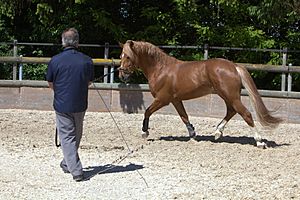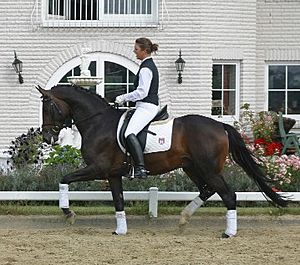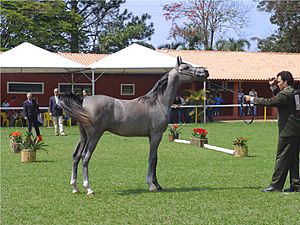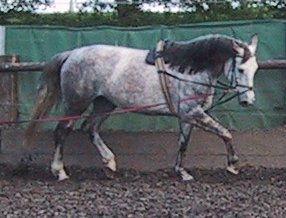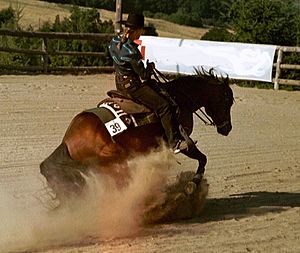Horse training facts for kids
Horse training is all about teaching horses to do certain things when people ask them to. This helps horses be safe and easy to handle for daily care. Horses also learn skills for fun activities like horse racing or even therapeutic horseback riding for people with special needs.
In the past, horses learned to help in wars, on farms, and for travel. Today, most training helps horses enjoy sports and hobbies with people. Horses can also learn special jobs. These include movie stunts, helping police, performing in circuses, and even helping people in therapy.
There are many different ways to train horses. Some methods are seen as kind, while others are thought to be harsh. This article will explain the basic ideas of horse training. You can find more details about specific methods in the "See also" section.
Contents
Why Train Horses? Goals of Training
Horse training has many goals, but the main one is to make horses safe for people. It also helps them learn useful tasks. Understanding how horses behave is key for any trainer.
Here are some important things to remember about horse training:
- Safety First: Horses are much bigger and stronger than humans. So, they must learn behaviors that keep people safe.
- Horses Think Differently: Horses do not think like humans. Trainers must understand horse psychology. This helps them guide the horse to learn what is expected.
- Herd Animals: Horses live in herds and can learn to respect a human leader.
- Prey Animals: Horses naturally react with "fight or flight" when scared. Training helps them learn to trust humans to know when it's safe.
- Start Early: Young horses learn new things more easily. Handling them from a young age helps them adapt to human expectations.
Steps in Horse Training
Most horses go through similar steps as they learn. This happens no matter what they are being trained for.
Training Foals and Young Horses
Most baby horses, called foals, are handled soon after they are born. Some people use "imprinting" to introduce a foal to human touch and sounds early on. This means touching the foal all over and picking up its feet within its first few days.
Other trainers let the foal bond with its mother first. But even then, they still handle the foal a lot while it is small. This teaches the foal that humans will not hurt it, but also that humans should be respected.
Even though foals are too young to ride, they can learn important skills. By the end of its first year, a foal should be "halter-broke." This means it lets a halter be put on its head. It should also learn to be led by a human at a walk and trot, stop when asked, and stand still when tied.
Young horses need to be calm for grooming and vet visits. They also need regular hoof care. They can learn to stand still while a farrier trims their feet. Ideally, a young horse learns to be caught from a field and loaded into a horse trailer. It should also not be afraid of flapping or noisy things. They can get used to everyday human sounds like cars and radios.
More advanced skills for foals include accepting blankets and baths. They might learn voice commands to start and stop. Some even learn to stand perfectly for horse shows. If these things are taught, the young horse will not fear things on its back or in its mouth.
Some people wait until a foal is weaned (separated from its mother) to start training. They believe the young horse will bond more easily with a human during this time. Sometimes, basic training continues when the horse is a yearling (one year old). Yearlings are bigger and can be easily distracted. But they are still very open to learning.
It is less common, but some horses are not handled until they are old enough to be ridden. This is usually between two and four years old. Training a full-grown horse for the first time can be riskier for humans. It also needs more skill to avoid injuries.
Ground Training for Horses
After a young horse learns to lead, other tasks can be taught before it is ridden. Some trainers do a lot of "ground work" with horses between one and two years old. This prepares them for riding. Others just keep the horse used to humans.
Young horses' bones are soft. So, intense work like roundpenning or longeing should wait until they are at least two years old. This prevents injuries.
Common ground training techniques include:
- Liberty work: Also called "round pen work." This is when a horse works loose in a small round area. The trainer uses voice and body language to ask the horse to move faster or slower, change direction, and stop.
- Longeing: (Pronounced "lunge-ing"). This teaches a young horse to move in circles at the end of a long rope.
- Desensitization: Also called "sacking out." This teaches a horse not to be afraid of flapping objects, like blankets. It helps the horse get used to being touched by different things.
- Getting used to equipment: This involves putting a saddle and bridle or harness on the horse. But no one gets on the horse or hooks up a cart yet.
- Ground driving: Also called "long-lining." This teaches a horse to move forward with a person walking behind it. This prepares the horse for pulling a cart or for a rider using reins.
- Bitting: This gets a horse used to having a bit and bridle in its mouth. Sometimes, side reins are used. These attach to a saddle or surcingle (a wide band around the horse's belly). This helps the horse get used to pressure from the bit.
A horse is ready to be ridden when it is comfortable with all its equipment. It must also respond to basic voice and rein commands to start, stop, turn, and change gaits.
Some ground work also helps horses develop muscles and learn specific behaviors. This can take longer, but trainers believe it helps the horse learn faster once ridden.
First Rides: "Backing" the Young Horse
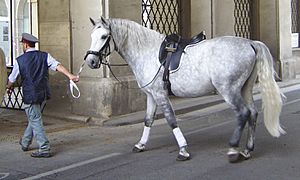
The age horses are first ridden, or "backed," varies. Some Thoroughbred racehorses have light riders on their backs as early as their yearling year. Most stock horses, like the American Quarter Horse, are ridden at age two. Many horses trained to pull carts start at age two. Most horses around the world are first ridden at age three. Some breeds, like the Lipizzaner, mature slower and are not ridden until age four.
Getting on a horse for the first time has many names. These include "backing," "breaking," or "mounting." The goal is for the horse to calmly allow a rider on its back or pull a cart. It should also respond to basic commands to go forward, change gaits and speed, stop, turn, and back up.
Ideally, a young horse will not be afraid of humans. It will see being ridden as just another new lesson. A well-trained young horse that had good ground work will rarely buck or run away when first ridden.
Horses that have never been ridden can learn at any age. It might take longer to teach an older horse. An older horse that is used to humans but has no bad habits is easier to train. A wild horse caught as an adult can also be trained. But a domesticated horse that has learned to disrespect humans can be harder to train.
Training for Specific Horse Sports
There are many ways to train horses, and the details are too vast for one article. Horses also have different body types, athletic abilities, and personalities. These all affect the training methods used. For more information on horse training and specific sports, see the "See also" section below.
See also
 In Spanish: Entrenamiento de caballos para niños
In Spanish: Entrenamiento de caballos para niños


